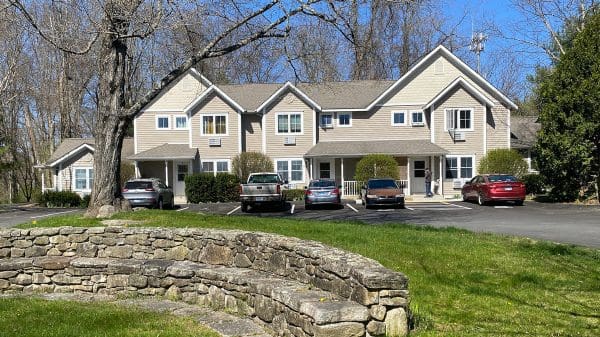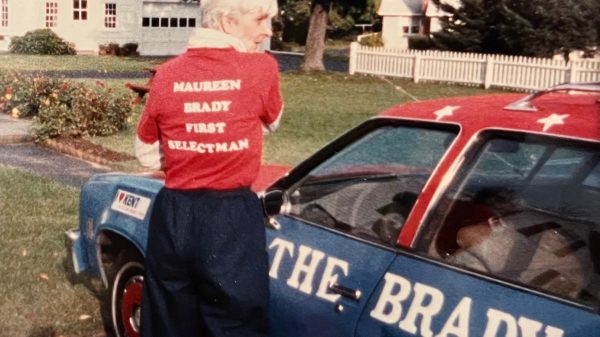KENT—The future of the venerable Swift House, presumably the oldest building still extant in the center of Kent, was heatedly debated at a selectmen’s meeting June 26. Surprisingly, by Monday, July 1, First Selectman Marty Lindenmayer had changed his focus and proposed a $500,000 upgrade that would make the building useful again.

On June 26, Lindenmayer argued that the town “should not be a commercial enterprise” holding a building for use by other organizations, a position forcefully opposed by Suzanne Charity, head of the Swift House Task Force and Selectman Lynn Mellis Worthington.
Lindenmayer argued that any application for a $500,000 STEAP grant should be directed toward improvements at the Community House, also town-owned and rented for a variety of uses. “I see it as a more imminently necessary use of STEAP grant,” he said, noting that acoustic changes could be made to the auditorium, meeting rooms could be created downstairs, a large generator could be installed, and exterior painting could be done.
Swift House, by contrast, is an 18th-century building that has not been adequately maintained in recent years and that has no clear future use for the town. An assessment of its needs created by the architectural firm Silver Petrocelli reported extensive restoration would be needed to bring it up to 21st-century codes at a cost of about $2 million.
The town has chewed on the problem of what to do with Swift House for years. It was rescued from near ruin in the past by benefactress Emily Hopkins and was purchased by the town in the early 1970s. Over the years, it has been the site of small gatherings and has been the headquarters for such organizations as the Kent Historical Society. When Covid struck in 2020, it was closed to the public and, unlike other public buildings, was not reopened following the epidemic because it did not meet modern ADA accessibility requirements.
Charity told the selectmen June 26 that the task force’s “hands have been tied” in planning for future uses because the building remains closed to the public. She asked that the task force be allowed to conduct focus groups through the building to brainstorm possible uses. Selectman Glenn Sanchez, also a member of the task force, has volunteered to escort the groups through the building.
“We want to talk about how it might be used in the future,” Charity said, adding that it is impossible to apply for grants with no plan in mind. At the same time the task force is seeking state and federal registry recognition for the building, also an integral part of the grant process.
“I don’t think we can do our work until we get information,” she said. “If there are not enough viable [proposals] to use it, and it goes on the market, we should still try to get certification” so the historic aspects of the building are preserved.
The task force has been working with the State Historic Preservation Officers to have the building included on the state and federal registers of historic places.
Charity referred to an earlier survey that showed support for the building, but Lindenmayer dismissed it. “I have seen the survey,” he said, “But I suspect any survey that people can go in and vote 40 times is not going to be good survey.”
Worthington advocated for allowing the public into the building to see its potential. “There is no way that people who have never been inside the building can see its potential,” she said. “We have to be more inclusive.”
“We’ve done the needs assessment,” said Charity. “Now we have to know the needs and wishes of the community. If we can build enough support from people, that’s an informed public—but we can’t do that if they have never been in the building.”
Lindenmayer said a decision had to be made soon because neglected buildings deteriorate rapidly. “it’s either going to be fixed or not,” he said. “It can’t continue too long.”
The advocates for the building advised that a handicap access and bathroom be provided immediately so the building can be opened to the public and said it would be an excellent candidate for a STEAP grant.
“An ADA bathroom would open building and put it in use and then we could raise money for other improvements,” said Charity, but Lindenmayer said applying for STEAP “is more than just developing a building when we don’t know what we will do with it.”
By Monday, he had solved the dilemma. With a Town Hall that is “bursting at the seams,” he proposed applying for a STEAP grant that would provide handicap access and an ADA-compliant bathroom on the ground floor of Swift House. He suggested that the town move its Social Services department and food bank to the building, with room left over for small meetings and activities.
“I could never get my arms around people coming in sporadically to use it,” he said after the meeting.
As he presented it to his board, he said he saw having social services and the food pantry adjacent to the Senior Center and Templeton Farms, the town’s housing for the elderly complex, as being a logical and efficient extension of town services.
The selectmen approved a STEAP grant application based on funding for Swift House upgrades.


























